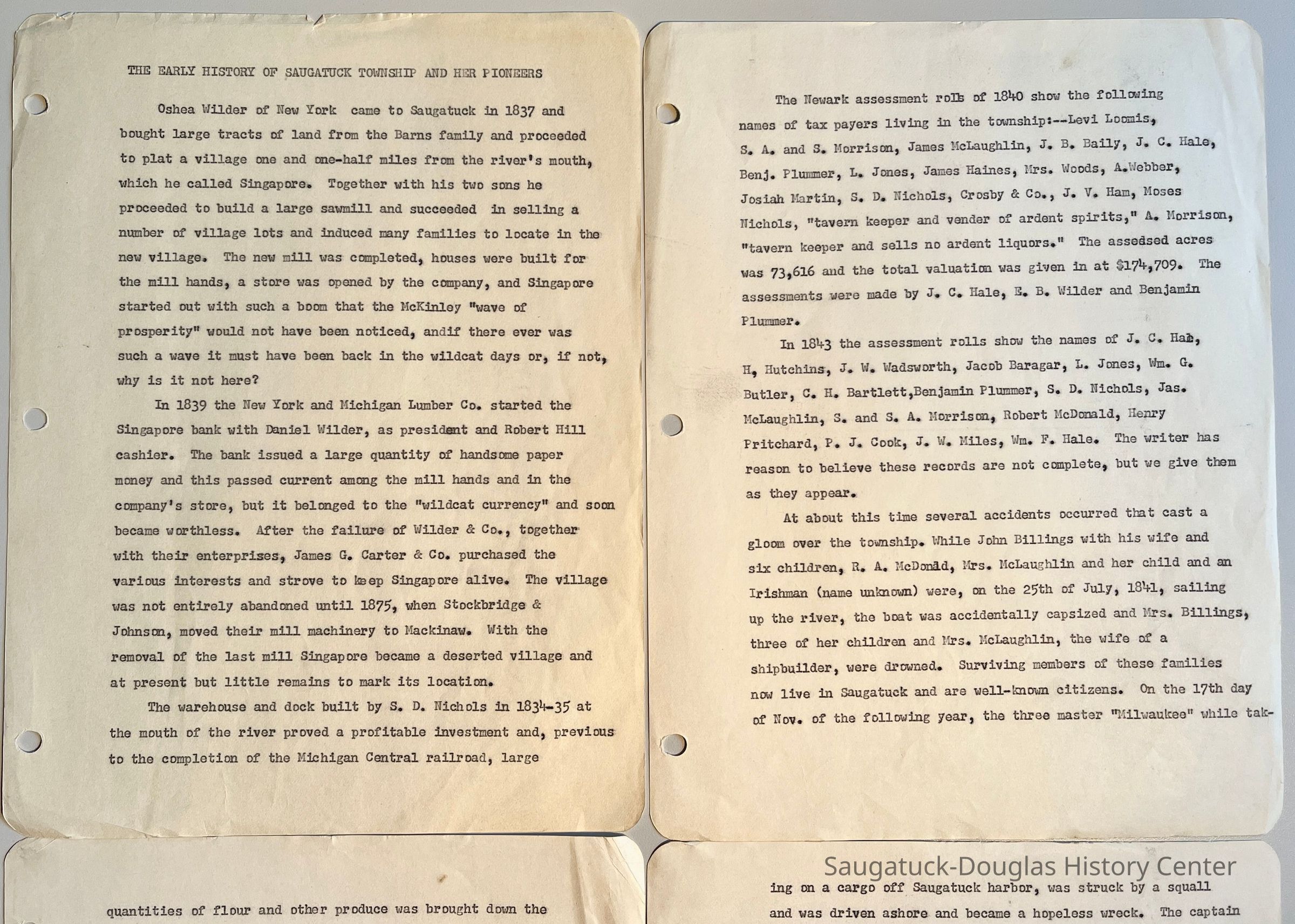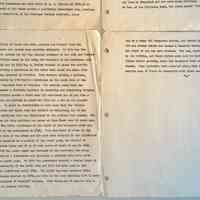Early History of Saugatuck Township and Her Pioneers

2021.18.60
1836 Singapore1830 Settlement, pioneer eraTransportation: water
2021.18
Lane, Kit, family
11 in
8-1/2 in
164 General local history
Wilder, OsheaSingapore Bank 1836-1842Griffin & Henry Lumber Yard/Griffin & Henry Sawmill/Griffin & Williams/Stockbridge & Johnson/Wells & Johnson/M.B. Spencer MillNichols, Stephen D. 1806-1887Billings, John Henry 1811-1874Milwaukie (ship) 1842Butler, William Gay 1799-1857Kalamazoo Lighthouses 1839/1858/1956-presentOld Harbor/Channel piers pre-1906/Ox-Bow Lagoon
Singapore, Michigan 1837-1875
THE EARLY HISTORY OF SAUGATUCK TOWNSHIP AND HER PIONEERS Oshea Wilder of New York came to Saugatuck in 1837 and bought large tracts of land fron the Barns family and proceeded to plat a village one and one half miles from the river's mouth, which he called Singapore. Together with his two sons he proceeded to build a large sawmill and succeeded in selling a number of village lots and induced many families to locate in the new village. The new mill was completed, houses were built for the mill hands, a store was opened by the company, and Singapore started out with such a boom that the McKinley "wave of prosperity" would not have been noticed, andif there ever was such a wave it must have been back in the wildcat days or, if not, why is it not here? In 1839 the New York and Michigan Lumber Co. started the Singapore bank with Daniel Wilder, as president and Robert Hill cashier. The bank issued a large quantity of handsome paper money and this passed current among the mill hands and in the company's store, but it belonged to the "wildeat currency" and soon became worthless. After the failure of Wilder & Co., together with their enterprises, James G. Carter & Co. purchased the various interests and strove to keep Singapore alive. The village was not entirely abandoned until 1875, when Stockbridge & Johnson, moved their mill machinery to Mackinaw. With the removal of the last mill Singapore became a deserted village and at present but little remains to mark its location. The warehouse and dock built by S. D. Nichols in 1834-35 at the mouth of the river proved a profitable investment and, previous to the completion of the Michigan Central railroad, large quantities of flour and other produce was brought down the Kalamazoo and stored here awaiting shipment. As this was the natural outlet for all the surplus products of the sol and forests from Battle Creek to the lake, the business at the warehouse grew rapidly and in 1835 Wn. G. Butler thought to share the profits by building a warehouse on the river bank about two miles from the one operated by Nichols. This venture proving a failure, Mr. Butler in 1842 built a warehouse on the south side of the river opposite that of Nichols. For several years both men transacted a thriving business in receiving and forwarding freight. Mr. Nichols opened a store near his warehouse and at one time a village was platted on paper but this was a far as the project went. It might be interesting to note here that the Nichols warehouse was taken down and rebuilt at Saugatuck, and it was this warehouse that was demolished by the cyclone last summer. The lumber for this building was sawed at Pine Creek over 60 years ago. The first lighthouse at the mouth of the Kalamazoo river was built by the government in 1838. This was built in stone on the north side of the river and the spot once occupied by the lighthouse is no occupied by a portion of the south pier, the channel of the river being now 20 or 30 rods north of where it was in 1838. In 1859 the stone tower was replaced by the structure now doing service as a lighthouse and occupying a position some rods north of the north pier. In 1875 the government erected a wooden tower at the extremity of the south pier and this has been used as the harbor lighthouse until 1891. The light has been returned tothe lighthouse erected in 1859, and this is the only building left to mark the location of Nichols' village. Like Singapore it remains only a part of pioneer history. The Newark assessment rols of 1840 show the follwing names of tax payers living in the township:--Levi Loomis, S. A. and S. Morrison, James MeLaughlin, J. B. Baily, J. C. Hale, Benj. Plummer, L. Jones, James Haines, Mrs. Woods, A Webber, Josiah Martin, S. D. Nichols, Crosby & Co., J. V. Ham, Moses Nichols, "tavern keeper and vender of ardent spirits," A. Morrison, "tavern keeper and sells no ardent liquors." The assedsed acres was 73,616 and the total valuation was given in at $174,709. The assessments were made by J. C. Hale, F. B. Wilder and Benjamin Plummer. In 1843 the assessment rolls show the names of J. C. Had, I, Hutchins, J. W. Wadsworth, Jacob Baragar, L. Jones, Wn. G. Butler, C. I. Bartlett,Benjamin Plummer, S. D. Nichols, Jas. MeLaughlin, S. and S. A. Morrison, Robert McDonald, Henry Pritchard, P. J. Cook, J. W. Miles, Wn. F. Hale. The writer has reason to believe these records are not complete, but we give them as they appear. At about this time several accidents occurred that cast a gloom over the township. While John Billings with his wife and six children, R. A. McDonad, Mrs. McLaughlin and her child and an Irishman (name unknown) were, on the 25th of July, 1841, sailing up the river, the boat was accidentally capsized and Mrs. Billings, three of her children and Mrs. McLaughlin, the wife of a shipbuilder, were drowned. Surviving members of these families now live in Saugatuck and are well-known citizens. On the 17th day of Nov. of the following year, the three master "Milwaukee" while taking on a cargo off Saugatuck harbor, was struck by a squall and was driven ashore and became a hopeless wreck. The captain and eight of his men were drowned. The sea, however, gave up its victims, and their bodies were laid to rest in the Indian burial grounds, where the Saugatuck town hall now stands. Many accidents have occurred since then and we may mention some of these in connection with other events. "G. "
Reactions to the text: "It's a very interesting read. It may imply the the Village of the Harbor of Kalamazoo extended to the south and east side of the mouth of the river as well. We can even figure a date to the document by what summer a cyclone hit Saugatuck and destroyed Nichols’ relocated warehouse. As to who was “G” it’s like that early account in the commercial about someone's recollections of the past as they revisited the area. That was a very informative read about the Carter & Stockbridge Mill at Singapore, and just worked its narrative upriver from there. It, too, was just signed by someone’s initials." -- James T. Faasen, 27 March 2025 "It reads like a transcript of a newspaper article. It was written after 1891 - and before 1914, if the lighthouse was still in use.There’s no mention of the new channel." -- Chris Clark, 28 March 2025
03/27/2025
04/06/2025


